R188 (New York City Subway car)
The R188 is a class of new technology (NTT) New York City Subway cars built by Kawasaki Heavy Industries for the A Division. The fleet entered service in 2013, displacing the 1980s-era R62A cars that operated on the 7 and <7> services, in conjunction with the automation of the IRT Flushing Line's signal system with communications-based train control (CBTC). The R188 order also expanded the 7's fleet as part of the 7 Subway Extension, which opened in 2015.
| R188 | |
|---|---|
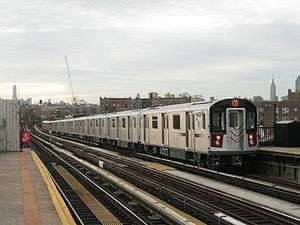 An R188 train on the 7 leaving 52nd Street | |
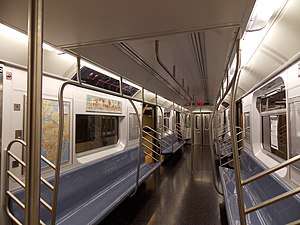 Interior of an R188 car | |
| In service | 2013–present |
| Manufacturer | Kawasaki Rail Car Company |
| Built at | Yonkers, New York, US and Kobe, Hyōgo, JP |
| Family name | R type contract series, NTT (new technology train) |
| Constructed | 2011–2016 |
| Entered service |
|
| Number built | 506 (126 new cars, 380 conversions) |
| Number in service | 506 (418 in revenue service during rush hours) |
| Formation | 5-car sets (A-B-B-B-A) 6-car sets (A-C-B-B-B-A) |
| Fleet numbers | Conversion Sets: 7211-7590 New Sets: 7811-7898 New "C" Cars: 7899-7936 |
| Capacity | 176 (A car) 188 (B & C cars) |
| Operator(s) | New York City Subway |
| Depot(s) | Corona Yard[1] |
| Service(s) assigned | 407 cars (37 trains, PM rush)[2] |
| Specifications | |
| Car body construction | Stainless steel with fiberglass end bonnets |
| Train length | 11 car train: 564.63 feet (172.10 m) |
| Car length | 51.33 feet (15.65 m) |
| Width | 8.60 feet (2,621 mm) |
| Height | 11.89 feet (3,624 mm) |
| Platform height | 3.6458 ft (1.11 m) |
| Doors | 6 sets of 54 inch wide side doors per car |
| Maximum speed | 55 mph (89 km/h) Service 70 mph (110 km/h) Design |
| Weight | "A" car: 73,332 pounds (33,263 kg) "B" and "C" cars: 67,721 pounds (30,718 kg) |
| Traction system | Bombardier MITRAC propulsion system, 3-Phase IGBT-VVVF two-level AC Traction Motors Model 1508C, Pulse-width modulation |
| Power output | 150 hp (111.855 kW) per motor axle 4,500 hp (3,355.649 kW) per 11 car train |
| Acceleration | 2.5 mph/s (1.1 m/s2) |
| Deceleration | 3.0 mph/s (1.3 m/s2) (full service), 3.2 mph/s (1.4 m/s2) (emergency) |
| Power supply | Third rail |
| Electric system(s) | 625 V DC |
| Current collection method | Contact shoe |
| Braking system(s) | WABCO RT-96 tread brake system; Dynamic braking propulsion system. |
| Safety system(s) | CBTC, Dead man's switch, tripcock |
| Track gauge | 4 ft 8 1⁄2 in (1,435 mm) |
Of the 506 cars in the fleet, only 126 were built brand-new; the remaining 380 cars were originally part of the R142A fleet that entered service in 2000, before being upgraded to R188s with the installation of CBTC equipment (7321-7325 were the first R142As to be upgraded to R188s and were converted in January 2015).[3] The fleet first entered passenger service on November 9, 2013, and the final cars were delivered in June 2016.
Description and features
The R188s are numbered 7211-7590 and 7811-7936. Cars 7211-7590 are former R142As that were converted to R188s, cars 7811-7898 are new cars built to supplement the increase in 7 service, and cars 7899-7936 are new "C" cars built to expand converted R142A sets from five cars to six cars (Most A-Division lines use 10-car trains, while the 7 and <7> services use 11-car trains, necessitating the addition of one new car to converted sets).
The R188s are equipped with the latest control systems, HVAC, and public address systems to guarantee the utmost safety and passenger comfort. They are nearly identical to the R142As but are equipped with CBTC. Therefore, these cars are compatible only with the converted R142As that feature CBTC.
Like the R142s, R142As, and R143s, the R188s feature the electronic strip map with all stops on the 7 route with an indicator that can be set to either a local or express train.
Experimental features
In June 2016, cars 7501-7510 and 7928 had their route signs modified with green circle/red diamond LED signs and a LED numbered-route display, similar to those on the R62As previously used on the 7. This modification was done to make it easier for passengers to differentiate between an express or local train. In the following year, car 7501 had the LCD destination indicator parts of its destination signs replaced with LED panels to make it aesthetically similar to the aforementioned route display.[4] It is currently unknown if the remainder of the rolling stock will be retrofitted with these features.
In April 2017, car 7502 was equipped with a special test truck, with wheels different from the traditional ones found on other cars, and a special electrical apparatus affixed to it.[lower-alpha 1]
In September 2018, cars 7847-7848 were fitted with new LCD advertisement screens, replacing the traditional paper advertisements that are usually located there.[lower-alpha 2]
History
Timeline of contracts
| All planned orders |
# of converted cars | # of new C cars | # of new A & B cars | |||
|---|---|---|---|---|---|---|
| Total | Total | Total | ||||
| Main order |
Option order |
Main order |
Option order |
Main order |
Option order | |
| Original proposal[5] | 140 | 46 | 320[note 1] | |||
| 10 | 130 | 3 | 43 | 20 | 300 | |
| 2010–2014 Capital Program[6] |
360 | 46 | 100 | |||
| 10 | 350 | 3 | 43 | 20 | 80 | |
| Final contract[7] | 380 | 46 | 80 | |||
| 10 | 370 | 3 | 43 | 20 | 60 | |
At the time that the R188 order was placed, forty R62A 11-car trainsets were assigned to the 7 service. The R188 order originally consisted of 186 new cars, as well as 131 converted R142A cars compatible with communication-based train control (CBTC) and an additional 189 R142A conversion kits for MTA, totaling a possible 506 cars, or in other words, 46 11-car trains. Of these 506 cars, 230 are arranged in 5-car sets while the remaining 276 are arranged in 6-car sets.[5] Six extra R188 trainsets were ordered in conjunction with CBTC installation and 7 Subway Extension. The trains are configured so that the five-car consist on each train is located on the Manhattan-bound end and the six-car consist is located on the Main Street-bound end, due to the position of conductor's boards on platforms along the 7 route.
According to the 2010–2014 capital plan, 146 new cars were to be purchased. Of these new cars, 110 cars would go to make up 10 new 11-car trains, while the remaining 36 cars were to be "C" cars that would go to expanding 36 CBTC upgraded R142A 5-car sets (360 existing cars) to 6-car length. The original planned total of 46 11-car trains (506 cars) would still result from this order.[6]
In the latest revision, however, only 88 new cars were to be purchased to form 8 new 11-car trains, with 38 "C" cars, rather than ten 11-car trains. Likewise, the number of conversion cars was altered to 370. This change was made with the knowledge that only two ten-car R62A growth sets for the mainline IRT would be needed, as opposed to the projected four sets, and thus the MTA and Kawasaki opted to convert two additional R142A train sets in place of manufacturing two new sets. The MTA also decided to have Kawasaki perform all of the conversions at the Yonkers plant instead of 207th Street Shop as part of that contract modification.[7]
The R188 contract was awarded in spring 2010 to Kawasaki Heavy Industries, who won by default since only two manufacturers qualified and Bombardier Transportation opted not to bid on the contract citing the small order and large requirement for engineering resources. The contract was specified at $87,094,272 for the base order, which consisted of 33 cars (23 new cars and 10 conversions), and $384,315,168 for the option order, which consisted of 473 cars (123 new cars, and 350 conversions) for a total price of $471,409,440.
Delivery
According to a February 2012 update, the MTA had expected to have 8 conversion sets in service by the time that the 7 Subway Extension is opened for revenue service. In addition, the breakdown of the trainsets has been disclosed. Operationally, the R188s are coupled as such:
A-B-B-B-A+A-B-B-B-C-A
where dashes signify link bars and the addition sign denotes couplers. Thirty-eight R142A B cars, therefore, were converted into R188 "C" cars, in addition to the 38 deliveries of new "C" cars (not including the "C" cars in the eight new 11-car sets).[8]
The 10 converted R142A cars from the base order (7211-7220) were completed in December 2011 at Kawasaki's Yonkers facility and were delivered for testing on the Flushing Line in 2012. The 23 new cars from the base order (two eleven-car sets, 7811-7832, and one conversion set "C" car, 7899) were completed in mid-2012, delivered in November 2013, and entered service in December 2013. The 66 new option cars (7833-7898) were also completed in mid-2012 and have been delivered, while the remaining 37 new cars and the 370 conversions were set to be converted and delivered from February 2014 until the 4th quarter of 2015.[9][10]
On November 9, 2013, the first R188 train, consisting of cars 7811-7821, were placed in service on the 7 train as part of its 30-day revenue acceptance test.[11] After successful completion, it entered revenue service by December 15, 2013. By July 2014, the delivery schedule had slipped by about 6–7 months.[12] However, delivery of the cars sped up; all remaining R188 cars were expected to be delivered by the end of July 2016, but the last R188 cars were delivered in late June 2016.[3]
Post-delivery
In January 2020, as part of an agreement between the MTA and Comedy Central to promote actress Awkwafina's TV show Nora From Queens, the default pre-recorded announcements on the R188s were replaced with those from Awkwafina for one week. The announcements from Awkwafina featured jokes in addition to the standard station announcements.[13][14][15] The agreement was the first time that the MTA has replaced train announcements as a form of advertising.[16]
Gallery
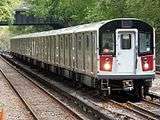 R188s 7811-7821 testing on the IRT Dyre Avenue Line at Gun Hill Road
R188s 7811-7821 testing on the IRT Dyre Avenue Line at Gun Hill Road.jpg) R188 destination sign
R188 destination sign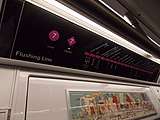 The electronic strip map of the R188, before the extension to Hudson Yards
The electronic strip map of the R188, before the extension to Hudson Yards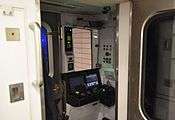 Driver's console of a R188 train
Driver's console of a R188 train.jpg) Modified R188 destination sign with a green circle denoting a local train
Modified R188 destination sign with a green circle denoting a local train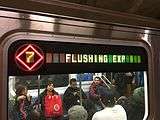 Modified R188 destination sign with a red diamond denoting an express train
Modified R188 destination sign with a red diamond denoting an express train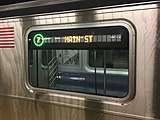 Further modified R188 destination sign with LED panels on car 7501
Further modified R188 destination sign with LED panels on car 7501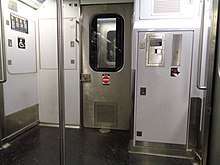 The CBTC console located behind the driver's cab
The CBTC console located behind the driver's cab
See also
- New Technology Train - A list of all NTT trains on the New York City Subway.
- R142A (New York City Subway car) - a similar car built by Kawasaki Railcar, most of which were rebuilt into R188s.
- R142 (New York City Subway car) - a similar car built by Bombardier Transportation.
Notes
- See also:
- Tech And Transit (April 12, 2017), ⁴ᴷ R188 7502 with a New Test Truck, retrieved April 5, 2017
- See also:
- Tech And Transit (September 6, 2018), R188s 7847 and 7848 with new LCD Advertisement Screens, retrieved September 27, 2018
- This was the total of 131 converted R142A cars compatible with communication-based train control (CBTC) and an additional 189 R142A conversion kits. The option order of 473 cars was broken down as follows: 163 new R188 cars, conversion of 124 R142/R142A cars, and providing 186 conversion kits of R142/R142As.
References
- http://web.archive.org/web/20191205124356/http://nyctrackbook.com/Images/Updates/P.xlii.pdf
- "Subdivision 'A' Car Assignments: Cars Required April 27, 2020" (PDF). The Bulletin. Electric Railroaders' Association. 63 (6): 14. June 2020. Retrieved June 1, 2020.
- Rebecca Harshbarger and Sheila Anne Feeney (January 26, 2016). "Subway cars of future include Wi-Fi, cameras, charging stations". am New York.
- "How a Group of Engineers Hacked a 113-Year-Old Subway System's Signs". Motherboard. August 3, 2017.
- http://www.thejoekorner.com/cars/r34188sol.pdf
- Page 92
- http://i42.tinypic.com/r2oqb8.jpg Modification to purchase document
- http://mta.info/mta/news/books/pdf/120227_1400_CPOC.pdf
- Page 100 (Document), or Page 108 (PDF reader) Archived November 25, 2010, at the Wayback Machine
- DVV Media Group GmbH. "CBTC trials on New York's Flushing Line". Railway Gazette. Retrieved August 24, 2014.
- "MTA | news | New Subway Cars Being Put to the Test". New.mta.info. November 18, 2013. Archived from the original on May 15, 2014. Retrieved August 24, 2014.
- "Archived copy" (PDF). Archived from the original (PDF) on August 1, 2014. Retrieved August 1, 2014.CS1 maint: archived copy as title (link)
- Goldbaum, Christina (January 16, 2020). "Awkwafina's Latest Role: Subway Announcer. New Yorkers Have Thoughts". The New York Times. ISSN 0362-4331. Retrieved January 17, 2020.
- "'Stop Manspreading!': Queens Native Awkwafina Takes Over 7 Train Subway Announcement". NBC New York. January 16, 2020. Retrieved January 17, 2020.
- "Queens-born actress Awkwafina will voice 7 train announcements for a week before her new show premieres". amNewYork. January 16, 2020. Retrieved January 17, 2020.
- "The MTA Is Now Turning Subway Announcements Into Ads, Starting With Awkwafina". Gothamist. January 16, 2020. Retrieved January 17, 2020.
External links
| Wikimedia Commons has media related to R188 (New York City Subway car). |
- nycsubway.org - NYC Subway Cars: R188
- Korman, Joe (December 4, 2017). "IRT Car Assignments". JoeKorNer.
- Korman, Joe (November 6, 2016). "New York City Subway Car Fleet June 2010 through November 2016". JoeKorNer.
- Kawasaki Rail Car, Inc.: R188
- Car Status/Assignment